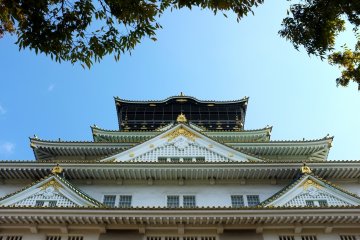
Осакский замок
Irma SyahriarПосещение Осакского замка дает шанс вернуться назад во времени и узнать больше о его историческом прошлом.

Osaka Castle is one of the city’s most iconic sites and draws numerous visitors to its spacious park and imposing keep every year.
Osaka Castle was first built by warlord Toyotomi Hideyoshi in 1583. From this stronghold, Hideyoshi put down rebellions and worked to unite the provinces of Japan. After his death, his former vassal Tokugawa Ieyasu took control of the country himself and established the longest running military rule in history. To quell any attempts of challenge from Hideyoshi’s former supporters, Ieyasu torched Osaka Castle in 1615, leaving it in cinders. The keep was later reconstructed by the Tokugawa clan, though fires and bombing raids have destroyed it several times. Today’s main tower dates from 1931 and has been recognized as an Important Cultural Property. A recent renovation from 1995-1997 added an elevator and made the keep completely accessible to disabled visitors.
The interior of the castle houses a history museum that details the life of Toyotomi Hideyoshi and the power struggles of the late 16th century. Approximately 10,000 items – including weaponry, armor, folding screens and personal letters – are displayed on a rotating basis. A movie theater offers a selection of five short films on the famed warlord; though the audio is in Japanese only, subtitles in multiple languages are provided. The top floor of Osaka Castle doubles as an observation desk, offering visitors a bird’s-eye view of the surrounding park and the golden shachiko (figures that resemble a cross between a fish and a tiger) that adorn the roof.
Those looking for a unique photo memory of their time in Japan may want to rent a samurai outfit, complete with headgear, from the castle’s costume corner. For a small fee, visitors can feel like they’re a part of feudal Japan.
In springtime, the grounds of Osaka Castle become the perfect picnic spot for sakura fans, as hundreds of cherry blossom trees shower the site with pale pink petals. Visitors can even take a boat ride on the castle moat, for a close-up glimpse of the imposing, stone fortifications.
Osaka Castle is easily accessible from a variety of metro stations that surround the grounds. There is an admission fee (¥600) to visit the main keep and the Ninomaru Garden (¥200).
To reach Osaka Castle, the nearest station is Osaka-jo-koen (大阪城公園) on the JR Loop Line.

Посещение Осакского замка дает шанс вернуться назад во времени и узнать больше о его историческом прошлом.

Замок Осака всегда был в тени из-за другого очень рекомендуемого замка, известного красотой своей архитектуры, замка Химэдзи. Замок Химэдзи, расположенный в соседней префектуре, Хёго, был на реконструкции уже довольно долго, так что в последние несколько лет я вместо него часто посещал замок Осака. Замок Осака подсвечен в ночное время, что подчеркивает его настоящую красоту, и я сфотографировал его с разных точек, например с территории замка и близлежащего Бизнес Парка Осака. Рекомендую посетить позним вечером.
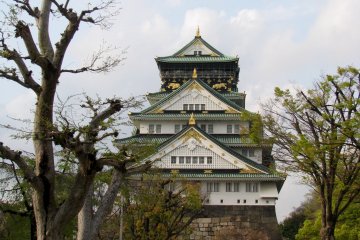
Опоздав в музей замка Осака, я не спеша осмотрела его окружение и полюбовалась закатом над городом. Также посетила храм Хококу, расположенный на территории замка.

Hotel MyStays Otemae в Осаке - замечательный выбор для остановки в Осаке. Отличное расположение, прекрасный сервис

Самым привлекательным в отеле Сити Плаза Осака (City Plaza Osaka) является спа, расположенная в стеклянной надстройке здания. В спа имеются горячие ванны, а рядом с помещением спа размещены зона отдыха и рестораны.
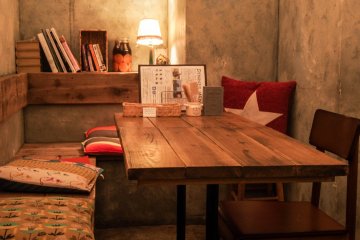
Три лучших вегетарианских ресторана в Осаке, специализирующиеся в приготовлении карааге на соевой курятине, карри из кокоса и чизкейки из тофу.
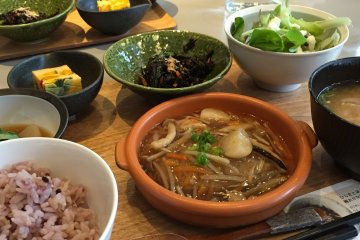
Япония славится своей здоровой пищей, но вегетарианцам или приверженцам органического питания бывает непросто подыскать подходящий ресторан. Вот несколько популярных в Осаке ресторанов, где подают то, что вам нужно.

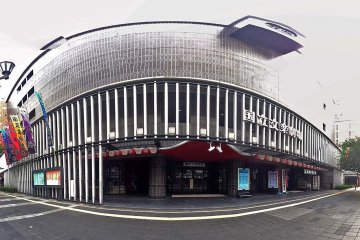
Osaka has been the capital of Bunraku, the traditional Japanese puppet theater, for many centuries. The National Bunraku Theater is a two-hall and exhibition room complex located in Chūō-ku, Osaka. The theater is now one of the few places where where the fascinating art form of bunraku can be seen. The complex opened in 1984 as the country's fourth national theater and became the headquarters of the Bunraku. The National Theater is operated by the Japanese Arts Council, an independent administrative body of the Ministry of Education, Culture, Sports, Science and Technology. English programs and headphones are available. The performances usually take place at three-week intervals in January, April, June, July / August and November.

Kuromon Market, or Kuromon Ichiba, is a staple destination among tourists and residents alike thanks to its abundance of fresh fish, meat, fruits, vegetables, sweets, clothes, and household/ miscellaneous items. The over 170-year old shopping street extends 580-meters long and is home to approximately 150 shops. Peruse large, commercialized shops alongside mom-and-pop spots and immerse yourself in the preserved food culture of Osaka. The lively atmosphere of shoppers, street food vendors, and tantalizing aromas will make for an unforgettable shopping experience. The historic market, officially established in 1902 with the name Enmyoji Ichiba, quickly gained the nickname Kuromon Ichiba, which translates to Black Gate Market, due to the nearby Enmyoji Temple’s renowned black-painted gate. Although the temple was completely destroyed by fire in the early 20th century, the market’s name still persists today. Although Kuromon Market has become a popular tourist destination, it still retains an authentic feel thanks to its local shoppers, cultural offerings, and down-to-earth vibes. The street is full of exciting finds, so be sure to explore them all! Pick up some preserved and pickled vegetables, wasabi root, bamboo shoots, wagyu beef, fugu (blowfish), strawberry daifuku (mochi covered strawberries), anime merchandise, or second-hand kimonos, to name a few. Given that you are surrounded by food, why not try some as well? Thankfully, the market is a hotspot for street food and quick bites on the go. Try some takoyaki, grilled scallops, sushi, oden (assortment of meat skewers, meatballs, fishcake, and daikon radish in a light soy-flavored dashi broth), kushisei (deep-fried meat skewers), okonomiyaki, fresh fruit juice, and so much more. Make sure you come to the market hungry and enjoy Osaka’s cuisine! As you explore the market please be mindful of your trash and support the cleanliness of the area. Towards the southern end of the market is the Kuromon Information Center. The center is a wonderful place to unwind after hours of walking and offers a seating area, toilets, a diaper changing table, a baggage counter, a currency exchange machine, and Chinese- and English-speaking staff onsite.
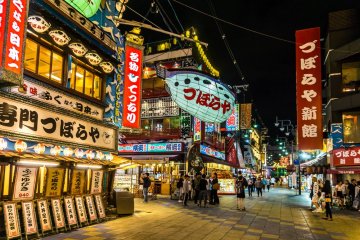
Dotonbori, located along the canal of the same name, is a street in the Namba district of Osaka’s Chuo ward that epitomizes the city’s nightlife. The colorful area is an explosion of neon lights, mouth watering street food, retro vibes, clubs, stores, and bars. A popular saying associated with the street is kuidaore, which roughly means to go bankrupt after spending an enormous amount of money on food. To experience the essence kuidaore (responsibly, of course) be sure to check out this renowned partying spot and lose yourself in the contagious energy! Roots in the 1600s The historic street started in the 1620s as a theater district with kabuki and bunraku (puppet) establishments along the canal. Over the years, many theaters closed as people lost interest in the traditional arts, and unfortunately, most of the remaining theaters were destroyed in bombing raids during WWII. Today, Shochiku-za Theater stands as the only reminder of the street’s theater roots. Today Today, Dotonbori is one of Osaka’s top tourist destinations. When the sun goes down, flashy neon advertisements light up along the canal and streets. The rainbow of colors illuminates the night air, creating an exciting atmosphere that matches Dotonbori’s offerings. Walk along the bustling street and lose yourself in the tantalizing food smells, energetic chatter, and hypnotizing sights. Embrace Kuidaore Food Culture With a phrase like kuidaore associated with the street, there is no doubt that Dotonbori takes its food culture seriously. The street is one of the best places to experience Osaka cuisine, and the area’s flamboyant restaurants themselves are a feast for the eyes. You will need multiple nights to enjoy all of the street’s wonders! For a personalized and unforgettable experience, book a food tour with a local who can guide you through the best spots. Discover Dotonbori's top restaurants. See the Sights! After, while, or before you eat, explore the vibrant area. Seemingly every spot of the street is filled with dazzling lights, historic vibes, and unique charm. Listed below are some of Dotonbori’s staple destinations. Though be sure to explore off of the beaten path and discover the street’s many wonders yourself!